Rugby, Warwickshire
| Rugby | |
|---|---|
| Market town | |
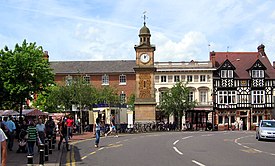 Rugby market place, looking west from Church Street | |
 Rugby Location within Warwickshire | |
| Population | 76,419 (2019 estimate) |
| Demonym | Rugbeian |
| OS grid reference | SP5075 |
| District |
|
| Shire county |
|
| Region |
|
| Country | England |
| Sovereign state | United Kingdom |
| Post town | RUGBY |
| Postcode district | CV21, CV22, CV23 |
| Dialling code | 01788 |
| Police | Warwickshire |
| Fire | Warwickshire |
| Ambulance | West Midlands |
| UK Parliament |
|
Rugby is a market town in eastern Warwickshire, England, close to the River Avon. In 2019 its population was estimated at 76,419,[1] making it the second-largest town in Warwickshire. It is the main settlement within the larger Borough of Rugby which has a population of 108,935 (2019 estimate).
Rugby is situated on the eastern edge of Warwickshire, near to the borders with Leicestershire and Northamptonshire. It is 83 miles (134 km) north of London, 30 miles (48 km) east-southeast of Birmingham, 11 miles (18 km) east of Coventry, and 19 miles (31 km) south-southwest of Leicester.
Rugby was a small rural market town until the mid-19th century, when the siting of a major railway junction at the town spurred the development of manufacturing and engineering industry, and the rapid growth of population.
Rugby School, an independent school situated in the town, is the birthplace of Rugby football which, according to legend, was invented in 1823 by a Rugby schoolboy William Webb Ellis.[2] The school was founded in 1567 and rose to national prominence as a public school in the 18th century.
History[]
Early history[]
Early Iron Age settlement existed in the Rugby area: The River Avon formed a natural barrier between the Dobunni and Corieltauvi tribes, and it is likely that defended frontier settlements were set up on each side of the Avon valley. Rugby's position on a hill overlooking the Avon, made it an ideal location for a defended Dobunni watch settlement. During the Roman period the Roman town of Tripontium was established on the Watling Street Roman road around 3.4 miles (5.5 km) north-east of what is now Rugby, this was later abandoned when the Romans left Britain.[3]
The small settlement at Rugby was taken over by the Anglo-Saxons around 560 AD, and it was mentioned in the Domesday Book of 1086 as Rocheberie; although there are several theories about the origin of the name, a popular one is that this was a phonetic translation of the Old English name Hrocaberg meaning 'Hroca's hill fortification'; Hroca being an Anglo-Saxon man's name pronounced with a silent 'H', and berg being a name for a hill fortification, with the 'g' being pronounced as an 'ee' sound. By the 13th century the name of the town was commonly spelt as Rokeby (or Rookby) before gradually evolving into the modern form by the 18th century.[3] In 1140 the first recorded mention was made of St Andrew's Church which was originally a chapel of the mother church at Clifton-upon-Dunsmore, until Rugby was established as a parish in its own right in 1221. In 1255 the lord of the manor Henry de Rokeby obtained a charter to hold a weekly market in Rugby, which soon developed into a small country market town.[4]
In the 12th century Rugby was mentioned as having a castle at the location of what is now Regent Place. However, the nature of the 'castle' is unknown, and it was possibly little more than a fortified manor house. In any event the 'castle' was short lived: It was probably constructed early in the reign of King Stephen (1135–1154) during the period of civil war known as The Anarchy, and demolished in around 1157 on the orders of King Henry II. The earthworks for the castle were still clearly visible as late as the 19th century, but have since been built over. According to one theory, the stones from the castle were later used to construct the west tower of St Andrew's Church, which bears strong resemblance to a castle, and was probably intended for use in a defensive as well as a religious role.[3][5]
Rugby School was founded in 1567 with money left in the will of Lawrence Sheriff, a locally born man, who had moved to London and made his fortune as the grocer to Queen Elizabeth I. Sheriff had intended Rugby School to be a free grammar school for local boys, but by the 18th century it had acquired a national reputation and gradually became a mostly fee-paying private school, with most of its pupils coming from outside Rugby. The Lawrence Sheriff School was eventually founded in 1878 to continue Sheriff's original intentions.[6][4]

During the English Civil War, King Charles I passed through Rugby in 1642 on his way to Nottingham, and 120 Cavalier Horse Troops reportedly stayed at the town, however the townsfolk were sympathetic to the Parliamentarian cause, and they were disarmed by the Cavalier soldiers. Later, in 1645, Rugby was strongly Parliamentarian, and Oliver Cromwell and two regiments of Roundhead soldiers stayed at Rugby in April that year, two months before the Battle of Naseby, some 12 miles (19 km) to the east, in nearby Northamptonshire.[3][4]
Until the 19th century, Rugby was a small and relatively unimportant settlement, with only its school giving it any notability. Its growth was slow, due in part to the nearby markets at Dunchurch and Hillmorton which were better positioned in terms of road traffic. In 1663 Rugby was recorded as containing 160 houses with a population of around 650. By 1730 this had increased to 183 houses, with a population of around 900. Rugby's importance and population increased more rapidly during the late 18th and early 19th century due to the growing national reputation of Rugby School, which had moved from its original location at a (now long vanished) schoolhouse north of St Andrew's Church, to its present location south of the town centre by 1750. By the time of the first national census in 1801, Rugby had a population of 1,487 with 278 houses. By 1831 this had increased further to 2,501 in 415 houses. This growth was driven by parents who wished to send their boys to Rugby School, but were unable to afford the boarding fees and so took up residence in Rugby.[7][8][3]
Modern history[]
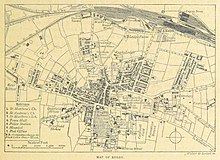
Rugby's growth into a significant town was prompted by the arrival of the railways, as its location made it an ideal meeting place for various railway lines, by the middle of the 19th century, the railway junction at Rugby had become one of the most important in the country: The first railway arrived in 1838 when one of the earliest inter-city main lines, the London and Birmingham Railway (L&BR) was constructed around the town. In 1840 the Midland Counties Railway made a junction with the L&BR at Rugby, which was followed by a junction with the Trent Valley Railway in 1847. By the mid-1850s there were five railway lines meeting at Rugby, with more than sixty trains a day passing through Rugby railway station.[7] Rugby was transformed into a railway town, and the influx of railway workers and their families rapidly expanded the population.[4] Rugby's population grew to nearly 8,000 by 1861.[8] reaching nearly 17,000 by 1901.[9]
In the later half of the 19th century, Rugby also developed some local industries: Large-scale cement production began in the town in 1862 when the Rugby Lias Lime & Cement Company Ltd was founded to take advantage of the locally available deposits of Blue Lias limestone.[10][3] A factory producing corsets was opened in 1882, this survived until 1992, by which time it was making swimwear.[4] In the 1890s and 1900s heavy engineering industries began to set up in Rugby, attracted by its central location and good transport links, causing the town to rapidly grow into a major industrial centre: Willans and Robinson were the first engineering firm to arrive in 1897,[11] building steam engines to drive electrical generators, they were followed by British Thomson-Houston in 1902, who manufactured electrical motors and generators. Both firms started producing turbines in 1904, and were in competition until both were united as part of GEC in 1969.[12] Rugby expanded rapidly in the early decades of the 20th century as workers moved in. By the 1940s, the population of Rugby had grown to over 40,000, and then to over 50,000 by the 1960s.[9]
A local board of health was established in Rugby in 1848, to provide the town with necessary infrastructure for its growth, such as paved roads, street lighting, clean drinking water and sewerage, this was converted into an urban district council in 1894. Rugby's status was upgraded to that of a municipal borough in 1932, and its boundaries were expanded to incorporate the formerly separate villages of Bilton, Hillmorton, Brownsover and Newbold-on-Avon which have become suburbs of the town.[8][13] In 1974 the municipal borough was merged with the Rugby Rural District to form the present Borough of Rugby.[14]
In the postwar years, Rugby became well served by the motorway network, with the M1 and M6 merging close to the town.[12]
Fame[]
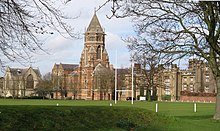
Rugby is most famous for the invention of rugby football, which is played throughout the world. The invention of the game is credited to William Webb Ellis, a Rugby School pupil who, according to legend, broke the existing rules of football by picking up the ball and running with it at a match played in 1823. Although there is little evidence to support this story, the school is credited with codifying and popularising the sport. In 1845, three Rugby School pupils produced the first written rules of the "Rugby style of game".[2]
Rugby School is one of England's oldest and most prestigious public schools, and was the setting of Thomas Hughes's semi-autobiographical masterpiece Tom Brown's Schooldays, published in 1857.[2] A substantial part of the 2004 dramatisation of the novel, starring Stephen Fry, was filmed on location at Rugby School. Hughes later set up a colony in America for the younger sons of the English gentry, who could not inherit under the laws of primogeniture, naming the town Rugby. The town of Rugby, Tennessee still exists.[15]
Rugby is a birthplace of the jet engine. In April 1937 Frank Whittle built and tested the world's first prototype jet engine at the British Thomson-Houston (BTH) works in Rugby, and during 1936–41 based himself at Brownsover Hall on the outskirts, where he designed and developed early prototype engines. Much of his work was carried out at nearby Lutterworth. Whittle is commemorated in Rugby by a modern sculpture near the town hall dating from 2005, made by Stephen Broadbent.[16][2][17]
Holography was invented in Rugby in 1947, by the Hungarian born inventor Dennis Gabor, also while working at BTH. For this he later received the Nobel Prize in Physics in 1971.[18]
In the 19th century, Rugby became famous for its once important railway junction which was the setting for Charles Dickens's story Mugby Junction.
Rugby today[]
The modern town of Rugby is an amalgamation of the original town with the former villages of Bilton, Hillmorton, Brownsover and Newbold-on-Avon which were incorporated into Rugby in 1932 when the town became a borough,[8][13] all except Brownsover still have their former village centres. Rugby also includes the areas of New Bilton, Overslade, Hillside and the partially constructed Houlton housing development. The spread of Rugby has nearly reached the villages of Clifton-upon-Dunsmore, Cawston, Dunchurch and Long Lawford.
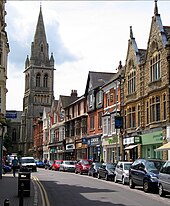
Town centre[]
The town centre is mostly Victorian and early 20th century, however a few much older buildings survive, along with some more modern developments. Rugby was described by Nikolaus Pevsner as 'Butterfieldtown'[19] due to the number of buildings designed by William Butterfield in the 19th century, including much of Rugby School and the extension of St Andrew's Church.
The main shopping area in Rugby is in the streets around the Clock Tower, two of which – High Street and Sheep Street – were pedestrianised in the 1980s.[4] Until the 19th century, Rugby's urban area consisted of only Market Place, High Street, Sheep Street, Church Street, North Street and what is now Lawrence Sheriff Street. These centred on what is now the Clock Tower, which was built in 1887 on the site of an ancient cross. These streets still form the core of the town centre. In the Victorian and Edwardian eras several more shopping streets were added in order to cater for the growing town, including Albert Street and Regent Street, the latter of which was built in 1905, and was intended to be Rugby's main shopping street, although it never achieved this goal.[3][20] The town centre has an indoor shopping centre called Rugby Central Shopping Centre which opened in 1979 (previously named The Clock Tower shopping centre).[4] A street market is held in the town centre several days a week. In recent years several out-of-town retail centres have opened and expanded to the north of the town, including: Elliots Field Retail Park, Junction 1 Retail Park and Technology Drive.
Geography[]

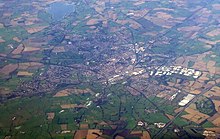
Most of Rugby sits around 400 feet (120 m) above sea level on an irregular shaped plateau which is situated between the valleys of the River Avon and Swift to the north, and the Rains Brook and River Leam to the south. During its modern growth, Rugby spread north across the Avon valley and enveloped the villages of Brownsover and Newbold, which are to the north of the Avon valley.[21][22]
The county boundary between Warwickshire, Northamptonshire and Leicestershire to the east of Rugby is defined by the A5 road (the former Watling Street) around 3 miles (4.8 km) east of Rugby town centre. The three counties meet at Dow Bridge; the point where the A5 road crosses the River Avon, forming a tripoint. To the south-east of Rugby the county boundary with Northamptonshire is defined by the Rains Brook.[21][23] Rugby is the easternmost town within Warwickshire (and the entire West Midlands region)
- Suburbs and districts
Suburbs and districts of Rugby include:
- Bilton
- Brownsover
- Hillmorton
- Hillside
- Kingsway
- New Bilton
- Newbold-on-Avon
- Overslade
- Adjacent settlements
Places adjoining or adjacent to Rugby, but not part of the town itself:
- Cawston
- Clifton-upon-Dunsmore
- Dunchurch
- Houlton (partially constructed)
- Long Lawford
- Nearby places
- Nearby cities: Birmingham, Coventry and Leicester
- Nearby towns: Bedworth, Daventry, Hinckley, Kenilworth, Leamington Spa, Lutterworth, Northampton, Nuneaton, Southam and Warwick.
- Nearby villages: Barby, Braunston, Brinklow, Catthorpe, Harborough Magna, Kilsby, Lilbourne, Monks Kirby, Newton and Pailton.
Demographics[]
At the 2011 census, there were 70,628 residents in Rugby in 30,901 households, and the median age of Rugby residents was 39.[24]
In terms of ethnicity:[24]
- 89% of Rugby residents were White (Comprising 81% White British, 6.5% Other White, 1.1% Irish and 0.1% Gypsy/Irish Traveller).
- 5.8% were Asian (Comprising 3.6% Indian, 0.8% Pakistani, 0.2% Bangladeshi 0.5% Chinese and 0.8% from another Asian background)
- 2.5% were Black (Comprising 1.2% African, 1.0% Caribbean and 0.3% other Black)
- 2.4% were Mixed.
- 0.1% were Arab and 0.2% were from another ethnic group.
In terms of religion, 62% of Rugby residents identified as Christian, 25.6% said they had no religion, 6.7% did not state any religion, 2.6% were Hindu, 1.6% were Muslim, 0.7% were Sikh, 0.3% were Buddhists, 0.1% were Jewish and 0.3% were from another religion.[24]
Politics and governance[]
National representation[]
From 1885 until 1983 Rugby was a constituency in itself, a status it regained in 2010. Rugby historically has been one of the Midlands' most marginal seats. From 1885 until 1924 Rugby was a marginal seat which changed hands between the Conservative and Liberal parties. From 1924 until 1942, the prominent Conservative David Margesson was Rugby's MP, his resignation triggered the 1942 Rugby by-election which was won by an independent trade unionist William Brown, who retained the seat until losing it to James Johnson of the Labour Party in 1950. From 1950 until 1983 Rugby was a Labour-Conservative marginal, with the Labour Party holding it for the majority of that period.[25]
In 1983 Rugby was joined with Kenilworth to become part of the parliamentary constituency of Rugby and Kenilworth. Between 1983 and 1997 Jim Pawsey was the Conservative Member of Parliament, losing in 1997 to Labour's Andy King. At the 2005 general election Jeremy Wright regained the seat for the Conservatives.[25]
Following the recommendations of the Boundary Commission for England, Warwickshire was allocated a sixth parliamentary seat. In the 2010 general election, the existing Rugby and Kenilworth constituency was abolished and split in two. A new Rugby constituency was created, and a new constituency of Kenilworth and Southam formed to the south of Rugby, and as a result the town regained its pre-1983 status of returning its own member of parliament, albeit with the addition of the Bulkington Ward from Nuneaton. Jeremy Wright chose to stand for Kenilworth and Southam in the 2010 general election and was successful. Mark Pawsey, son of former Rugby MP Jim Pawsey, was elected for Rugby in 2010.[25]
Local government[]
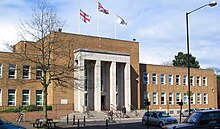
Rugby is administered by two local authorities: Rugby Borough Council which covers Rugby and its surrounding countryside, and Warwickshire County Council. The two authorities are responsible for different aspects of local government. Rugby is an unparished area and so does not have its own town council.
The Borough of Rugby was created in its current form in 1974, with the first elections held in 1973, since then, Rugby Borough Council has spent the majority of its time under no overall control, but since 2018 it has been controlled by the Conservative Party (see Rugby Borough Council elections)
Public services[]
Rugby is covered by Warwickshire Police and Warwickshire Fire and Rescue Service. Ambulance services are covered by the West Midlands Ambulance Service.
The local hospital in Rugby is the Hospital of St. Cross which is part of the University Hospitals Coventry and Warwickshire NHS Trust.[26] A more extensive range of health services are provided at the University Hospital Coventry, some ten miles away.[27]
Culture and recreation[]
The largest general purpose venue in Rugby is the Benn Hall which opened in 1961 as part of the town hall complex,[28] Rugby has two theatres, a professional theatre the Macready Theatre, and the amateur Rugby Theatre, both in the town centre.[29] A nine screen cinema run by Cineworld is located at a retail park north of the town centre.[30]
The Rugby Art Gallery, Museum & Library which opened in 2000, hosts various temporary art exhibitions, the main collection which is not on permanent display is the nationally renown "Rugby Collection of 20th century and Contemporary British Art" which includes 170 artworks by artists such as L. S. Lowry, Stanley Spencer, Paula Rego and Graham Sutherland.[31] The museum hosts Roman artefacts excavated from the nearby Romano-British town of Tripontium, as well as an exhibition of the social history of Rugby. The building also houses the World Rugby Hall of Fame as well as the town's library.[32]
The Webb Ellis Rugby Football Museum also in the town centre also hosts rugby memorabilia.
Since 2011 Rugby has held the annual Rugby Festival of Culture, which lasts for two or three weeks in June and July, and includes a wide-ranging program of music, theatre, arts and crafts and comedy.[33][34]
The poet Rupert Brooke was born and raised in Rugby, and he is commemorated in the town by a statue in Regent Place.[35]
In the 1960s, Clifton Hall at Rugby was owned by the music manager Reginald Calvert and became a centre of the Midlands rock music scene, with a number of Midlands bands such as The Fortunes, and the local band Pinkerton's Assorted Colours starting their careers there.[36] In the 1980s the influential rock band Spacemen 3 was formed in Rugby by the local musicians Jason Pierce and Pete Kember. Following its demise in 1991, both musicians went on to form successful subsequent projects; Pierce formed the critically acclaimed band Spiritualized and Kember continued performing under the names Sonic Boom/Spectrum.[37] Other notable musical acts to emerge from Rugby include the 1970s pop band Jigsaw which was formed by musicians from Rugby and Coventry,[38][39] the 2000s singer-songwriter James Morrison, and more recently Emily Burns.[40]
There are two large urban parks in the town centre, one is Caldecott Park alongside the town hall,[41] and on the edge of the town centre is the .[42]
Rugby has an indoor leisure centre, the Queen's Diamond Jubilee Centre which opened in 2013, replacing the older Ken Marriott Leisure Centre, it is run by GLL a charitable social enterprise on behalf of the local council.[43]
Sport[]
- Rugby has a number of rugby union teams including; the Rugby Lions, Rugby Welsh, Rugby St. Andrews RFC, Newbold-on-Avon RFC AEI (Rugby) Rugby Football Club and Old Laurentian RFC.
- Rugby has two non-league football clubs, Rugby Town F.C., who play in the United Counties League Premier Division, and Rugby Borough F.C., formed in 2017, who were Leicestershire Senior League Division One Champions in 2017–18.
- There are two golf courses near the town: Rugby Golf Club to the East, and Whitefields Golf Club to the South West.
Economy[]
For most of the 20th Century manufacturing was the largest employer in Rugby. Manufacturing employment peaked in the 1950s, and has gone into steady decline since, and service industries are now the largest source of employment.[44] Rugby remains an engineering centre and has a long history of producing gas and steam turbines and electrical equipment. Engineering in Rugby has taken place under a myriad of different companies; it was established in the 1900s by British Thomson-Houston (BTH) and Willans & Robinson, which later became parts of Associated Electrical Industries (AEI) and English Electric respectively, until both were united as part of the General Electric Company (GEC) in the late-1960s, which itself merged with Alstom in 1989. Most of the engineering works in Rugby were based in the Avon valley area north of the railway station, since the 1980s much of the engineering works have closed with their land sold off for housing and commercial development, however engineering still continues in Rugby on a smaller scale under the auspices of GE Power Conversion, which produces large electric motors, and services and manufactures steam turbines. In 2019 the Rugby site was threatened with closure, but was saved following an order for motors from the Ministry of Defence, after the House of Commons Defence Select Committee, decided that closing the site would lead to a ‘loss of sovereign capability and security’.[45][46]
Further afield, within the Rugby borough is the Rolls-Royce engineering works near Ansty. This is nearer to Coventry than Rugby.
Rugby is also a centre of laser manufacturing: This was started by the local firm JK Lasers, which was founded in 1972. In 1982 JK Lasers merged with Lumonics of Canada and was for a time one of the largest industrial laser companies in the world.[47] Following takeovers and mergers, the JK Lasers brand name disappeared in 2015, and it is now part of SPI Lasers, a subsidiary of the Trumpf company.[48][49] In 2018, SPI Lasers announced that their manufacturing site at Rugby was to be doubled in size.[50] A second laser manufacturing firm in Rugby is Litron Lasers, which was established in 1997.[51][52]

Another major industry in Rugby is cement making; This industry started on a small scale locally in the early 19th century, but began on a large scale in the 1860s when the Rugby Cement company was founded, making cement from the local Jurassic Blue Lias limestone at New Bilton. The current cement works at Rugby has the largest cement kiln in the UK, capable of producing 1.8 million tonnes of cement a year.[53] The current plant was opened in 2000, having been rebuilt and substantially enlarged in the late-1990s, upon its opening other Rugby Cement plants at Southam and Rochester were closed, with all production moved to the enlarged Rugby plant.[54] Rugby Cement was taken over in 2000 and is now owned by the Mexican firm Cemex, who moved their UK headquarters to Rugby in 2018.[55]
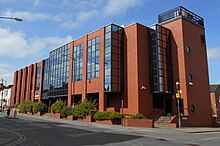
The American fashion retailer Gap Inc. has had its UK headquarters and distribution centre in Rugby since 2002,[56] as does the construction firm Morgan Sindall,[57][58] and the historic legal firm Brethertons.[59] In addition a number of trade, professional and charitable organisations have headquarters in Rugby, including the Institution of Chemical Engineers,[60] the Institution of Lighting Professionals,[61] the Master Locksmiths Association,[62] the Auto-Cycle Union,[63] the Oral Health Foundation,[64] and the development charity Practical Action.[65]
Since the 1980s several large industrial estates have been built to the north, and warehousing, distribution and light industry have become major employers. This is due to the town's close proximity to the M6 motorway (Junction 1) and M1 (Junction 19), at the heart of the UK's motorway network.[3] In 2017 nearly half of Warwickshire's businesses in the ‘Transport and storage’ sector were in Rugby.[66] In 2017 Hermes opened its 'Midlands Super Hub' parcel delivery depot at the Rugby Gateway development to the north of the town, which is the largest of its type in the UK.[67] To the east of Rugby is the large Daventry International Rail Freight Terminal (DIRFT), which opened in the 1990s; although this is across the county border in Northamptonshire, it is closest to Rugby.
Tourism is also important to the town's economy, especially related to Rugby football.[68]
In 2017 the average annual workplace wage in the Rugby borough was £29,059; above the Warwickshire (£28,513) and UK (£28,296) averages.[66]
One of the last links to Rugby's rural past was the cattle market held near the railway station, and earlier in the "Market Place" in the old centre of Rugby since medieval times. The market near the railway station was closed in late 2008 and the site has been redeveloped into housing, a hotel and a Tesco store as part of a wider scheme of work in the station area.
Notable buildings and landmarks[]

One of the most notable landmarks around Rugby was, until August 2007, the Rugby Radio Station, a large radio transmitting station just to the east of the town. The station was opened in 1926, at its height in the 1950s it was the largest radio transmitting station in the world, with a total of 57 radio transmitters, covering an area of 1600 acres. Traffic slowly dwindled from the 1980s onwards, and the site was closed between 2003 and 2007.[69] Several of the masts were decommissioned and demolished by explosives in 2004, although a few, including four of the biggest masts remained until 2007. (Firing the explosive charges was delayed by rabbits gnawing the wires).[70] The remaining four 'tall' masts were demolished on the afternoon of 2 August 2007 with no prior publicity. The site is now being developed as a new housing development known as Houlton
Rugby Cement works, to the west of the town, can be seen from as far away as the Cotswolds and the Malvern Hills in Worcestershire.[71] Standing at 115 metres high, the landmark is controversial; in 2005 it came in the top ten of a poll of buildings people would like to see demolished on the Channel 4 television series Demolition.[72] In October 2006, the owners of the Rugby Cement works, Cemex, were fined £400,000 for excessive pollution after a court case brought by the Environment Agency.[73]
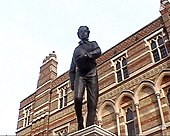
The town has statues of three famous locals: Rupert Brooke, Thomas Hughes and William Webb Ellis. The Rupert Brooke statue is situated at the forked junction of Regent Street on the green and commemorates his contribution to poetry. Thomas Hughes' statue stands in the gardens of the Temple Reading Rooms (the central library of Rugby school) on Barby Road. Since England won the Rugby World Cup in 2003, the William Webb Ellis statue outside Rugby School is one of the most visited parts of the town.
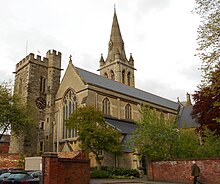
St Andrew's Church, in the town centre, is Rugby's original Church of England parish church. A church has stood on the site since 1140. The oldest surviving part of the church is the 22 metre high west tower which bears strong resemblance to a castle turret, the west tower was possibly built during the reign of Henry III (1216–1272) to serve a defensive as well as religious role, and is Rugby's oldest building. The church has other artefacts of medieval Rugby including the 13th-century parish chest, and a medieval font. The church was extensively re-built and expanded in the 19th century, designed by William Butterfield. The expanded church included a new east tower, added in 1895 which has a spire 196 feet (60 m) high.[3] The church is Grade II* listed.[74] Very unusually, both of the church towers have ringable bells, the main peal of bells (all cast in 1896 by Mears & Stainbank, London) being located in the eastern tower, and the old peal (all cast in 1711 by Joseph Smith of Edgbaston) located in the western tower.[75]
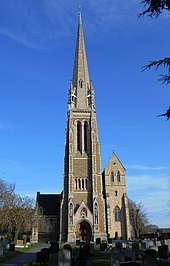
Rugby's main Roman Catholic church is St Marie's on Dunchurch Road. It is one of the town's most well-known landmarks as it is quite dominant on the skyline. The church was first opened in 1847, designed by Pugin in the Gothic revival style, it was enlarged in 1864, and in 1872 the current tall and slender spire was added, which is nearly 200 feet (61 metres) tall.[3][4] The church is also Grade II* listed.[76]
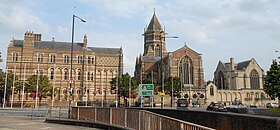
The buildings of Rugby School are major landmarks mostly dating from the 18th and 19th century with some early 20th Century additions. The oldest buildings are the Old Quad Buildings and the School House the oldest parts of which date from 1748, but were mostly built between 1809 and 1813 by Henry Hakewill, these are are Grade II* listed.[77][78] Most of the current landmark buildings date from the Victorian era and were designed by William Butterfield: The most notable of these is the Chapel, dating from 1872, which is Grade I listed.[79] Butterfield's New Quad buildings are Grade II* listed and date from 1867–85. The War Memorial chapel designed by Charles Nicholson is a later addition dating from 1922.[80][81]

Rugby's Clock Tower in Market Place is one of the town's best known landmarks, which traditionally marks the centre of Rugby. The clock tower dates from 1887, and was built to celebrate Queen Victoria's jubilee. It is built of Derby Dale stone, and was designed by Goodacres of Leicester. It is grade II listed.[82][83]
Places of interest[]
Places of interest in the town include:
- The , which has audio-visual displays about the history of Rugby School and of the town.
- The combined art gallery and museum. The art gallery contains a nationally recognised collection of contemporary art. The museum contains, amongst other things, Roman artefacts dug up from the nearby Roman settlement of Tripontium. The facility became the physical home of the World Rugby Hall of Fame in 2016.[84]
- The Webb Ellis Rugby Football Museum, where traditional rugby balls are handmade. It contains much rugby football memorabilia.
- The Benn Hall, a conference, seminar, exhibition and party venue.
- Newbold Quarry Park, nature reserve
- Swift Valley Nature Reserve
Places of interest around Rugby include:
- Brandon Marsh
- Brownsover Hall
- Coombe Abbey
- Coton House
- Dunchurch – Historic village
- Draycote Water – Reservoir and nature reserve
- Oxford Canal
- Ryton Organic Gardens
- Stanford Hall
Transport[]
Road[]
Rugby is situated near to several major trunk routes including the M1, M6 and M45 motorways, and the A5, A14 and A45 roads. Other main roads in the town include the A426 road, the A428 road and the Rugby Western Relief Road, linking the A45 with the Leicester Road, that connects with junction 1 of the M6.
In 2010, a short local bypass was opened; it was the first part of the Rugby Western Relief Road. It runs from the A428 (Lawford Road), along the edge of the built-up area to the A4071 (road from Rugby through Bilton and Cawston), a little west of Cawston; it takes through heavy traffic off suburban housing roads such as Addison Road. On 10 September 2010, the final part of Rugby's Western Relief Road was opened. The road runs from Potsford Dam near Cawston, through the Lawford Road and ending at Newbold Road, near the Avon Valley School. The initial estimated cost was projected at £36.6 million, while the final figure was in excess of £60 million.[85]
Bus[]
Buses run to Coventry, Southam, Leamington Spa, Daventry, Leicester and Northampton, as well as serving the major estates of the town on a regular basis. Stagecoach in Warwickshire have a depot in the town.
Railways[]
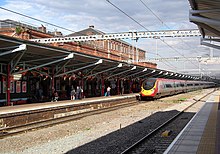
Rugby railway station is served by the West Coast Main Line and has frequent regular services to London Euston, Birmingham New Street, Stafford and Crewe. There are also some infrequent services between Rugby and Glasgow Central, the North West of England, Shrewsbury, Chester and Holyhead.
Rugby has had a railway station since 1838, when the London and Birmingham Railway was opened, though the present station dates from 1885. Rugby station used to be served by lines which have now been closed, including to Leicester, Leamington Spa and Peterborough. These were closed in the 1960s as part of the Beeching cuts.[86]
Between 1899 and 1969, Rugby had a second station; Rugby Central station on the former Great Central Main Line, which had services to London Marylebone to the south and Leicester, Nottingham and Sheffield to the north. The station and line were closed in the 1960s as part of the Beeching cuts.[86]
British Railways' was in Rugby.[86]
Warwickshire County Council have proposed a new station; Rugby Parkway station be built on the Northampton Loop Line, south-east of the existing station, serving the Hillmorton area of the town, and the new development at Houlton. The station is to be built in between the current edge of town and DIRFT to accommodate for the future expansion of the town where 6,200 homes are planned to be built over a 15 to 20 year period. No date, however, has been given for the opening of this station.[87]
Air[]
There are direct railway links to the nearest major airport Birmingham Airport. The smaller Coventry Airport is also nearby.
Canal[]
The Oxford Canal meanders through the borough of Rugby. There are over 1,000 moorings along the route in marinas, online moorings and farm moorings, as well as numerous canal businesses[citation needed]. The route was completed in 1790, but was shortened by approx 14 miles in the 1800s. Several arms of the canal, closed during the 1800s, have been reopened for moorings and canal businesses[citation needed].
Notable residents[]
Born in Rugby[]
- Chris Adams (1955–2001), wrestler
- Neil Adams (born 1958), judoka
- Melanie Astles, (born 1982) French aerobatic champion
- David Barby (1943–2012),[88] antiques expert
- Ian Bell (born 1982), cricketer
- Laura Bettinson (born 1987), singer-songwriter
- Andrew Bloxam (1801–1878), clergyman and naturalist
- Matthew Bloxam (1805–1888), antiquarian and archaeologist
- Arthur Bostrom (born 1955),[88] actor
- Rupert Brooke (1887–1915), poet
- Ben "Yahtzee" Croshaw (born 1983), comedic writer
- Jim Dewes (born 1957), cricketer
- Walter Gilbert (1871–1946), sculptor
- Herbert Haddock (1861–1946),[89] ship captain
- Michael John Harrison (born 1945), writer
- Peter Kember (born 1965), musician (Spacemen 3, Spectrum)
- Richard Lindon (1816–1887), leatherworker, inventor
- Norman Lockyer (1836–1920), scientist, discovered the gas helium
- Rose Macaulay (1881–1958), writer
- Katharine Merry (born 1974), sprinter
- James Morrison (born 1984),[88] singer-songwriter
- James Petiver (1665–1718), botanist
- Jason Pierce (born 1965),[88] musician (Spiritualized, Spacemen 3)
- Tim Pigott-Smith (1946–2017),[88] actor
- Peter Rogers (1947-2020), businessman
- Sam Ruddock (born 1990), track and field athlete
- Lawrence Sheriff (c. 1510–1567), grocer, philanthropist
- Barbara Stocking (born 1951), public servant
- Lauren Taylor (born 1994), golfer
- Chris Wakelin (born 1992), snooker player
- Peter Whalley (1722–1791), clergyman, academic and schoolmaster
- Mona Wilson (1872–1954), civil servant and author
- Arnold Wolfendale (1927–2020), Astronomer Royal
- Albert Wratislaw (1822–1892), clergyman and scholar
Lived or lives in Rugby[]
- Joseph Addison (1672-1719),[90] writer and politician
- Matthew Arnold (1822–1888), poet
- Thomas Arnold (1795–1842), educator
- Emily Burns (born 1994), singer-songwriter
- Lewis Carroll (1832–1898), writer
- Neville Chamberlain (1869–1940), politician
- Paul Dirac (1902-1984), physicist
- William Webb Ellis (1806–1872), clergyman, claimed inventor of rugby football
- Reginald Foort (1893–1980), organist
- Dennis Gabor (1900–1979), physicist
- Thomas Hughes (1822–1896), writer
- Billy J. Kramer (born 1943),[91] singer
- Unity Mitford (1914–1948),[92] socialite
- John Moultrie (1799–1874), clergyman and poet
- Kevin Painter (born 1967), darts player
- Peter Purves (born 1939),[88] television presenter
- Salman Rushdie (born 1947), novelist
- Franco Wanyama (1968–2019), boxer
- Frank Whittle (1907–1996), inventor
- Clem Wilson (1875–1944), cricketer
- Johnny Williams (1926–2007), boxer
Education[]
Primary[]
- State schools
- Abbots Farm Junior School
- Abbots Farm Infant School
- Bawnmore Infant School
- Bilton Infant School
- Bilton CE Junior School
- Boughton Leigh Infant
- Boughton Leigh Junior
- Brownsover Community Infant School
- Cawston Grange Primary School
- Clifton-upon-Dunsmore Primary School
- Eastlands Primary School
- English Martyrs Catholic Primary School
- Henry Hinde Infant School
- Henry Hinde Junior School
- Hillmorton Primary School
- Northlands Primary School
- Oakfield Primary Academy
- Paddox Primary School
- Riverside Academy
- Rokeby Infant School
- Rokeby Junior School
- Rugby Free Primary School
- St Andrew's Benn CE Primary School
- St Gabriels's CofE Academy
- St Maries RC Infant School
- St Maries RC Junior School
- St Matthews Bloxham CE Primary School
- Independent
Secondary[]
- Comprehensive Schools
- Ashlawn School
- Avon Valley School
- Bilton School
- Harris Church of England Academy
- Houlton School (to open September 2021)
- Lawrence Sheriff School (for boys)
- Rugby High School for Girls
- Ashlawn School – Partially Selective
- Independent schools
- Rugby School
- Princethorpe College
Further education[]
- Rugby College – which is a part of the Warwickshire College Group.
- Percival Guildhouse - Independent adult education charity.
Former schools and colleges[]
- Bishop Wulstan School
- Hillbrow School
- William Temple College (1954–71): an Anglican theological college.
Local media[]
Radio[]
The local radio stations are:
- BBC Coventry & Warwickshire: 104.0 FM
- Free Radio Coventry & Warwickshire (formally known as Mercia Sound and Mercia FM): 97.0FM
- Capital Mid-Counties: 107.1 FM
Written media[]
The main local newspapers are:
- The Rugby Advertiser
- The Rugby Observer
- The Warwickshire Telegraph; a localised sub-edition of the Coventry Telegraph.
Television news[]
The Rugby area is covered on regional TV News by:
- BBC Midlands Today
- ITV News Central
Twin towns[]
Rugby is twinned with:[4]
 Évreux, France (since 1959)
Évreux, France (since 1959) Rüsselsheim, Germany (since 1977)
Rüsselsheim, Germany (since 1977)
See also[]
- Rugby, North Dakota
- Rugby, Tennessee
- Rugby, New South Wales, Australia
References[]
- ^ "Rugby (Warwickshire)". Rugby on City Population. Retrieved 14 February 2021.
- ^ Jump up to: a b c d "Six ways the town of Rugby helped change the world". BBC. Retrieved 11 March 2019
- ^ Jump up to: a b c d e f g h i j Osbourne, Andy, Rawlins, Eddy (1988). Rugby: Growth of a Town.
- ^ Jump up to: a b c d e f g h i "Rugby history timeline". Rugby Local History Research Group. Archived from the original on 20 September 2016. Retrieved 30 August 2016.
- ^ Wait, Rev W.O. (1893). "Rugby:past and present, with an historical account of neighbouring parishes". pp. 38–47.
- ^ "SHERIFF, Lawrence". Rugby Local History Group. Archived from the original on 12 April 2018. Retrieved 11 April 2018.
- ^ Jump up to: a b Rugby, Further Aspects Of The Past (1977) Rugby Local History Group
- ^ Jump up to: a b c d "THE BOROUGH OF RUGBY". British History Online. Archived from the original on 8 March 2018. Retrieved 7 March 2018.
- ^ Jump up to: a b "Administrative unit Rugby MB/UD Local Government District". Vision of Britain. Archived from the original on 8 March 2018. Retrieved 7 March 2018.
- ^ "Rugby Portland Cement Company Ltd". Cement Kilns. Archived from the original on 26 October 2018. Retrieved 25 October 2018.
- ^ "THE WILLANS WORKS". Our Warwickshire. Archived from the original on 8 March 2018. Retrieved 7 March 2018.
- ^ Jump up to: a b "Industrial Town – From 1836 to now". Rugby Local History Group. Archived from the original on 8 March 2018. Retrieved 7 March 2018.
- ^ Jump up to: a b visionofbritain.org Archived 30 September 2007 at the Wayback Machine
- ^ "Timeline History of Rugby". VisitorUK. Retrieved 4 May 2018.
- ^ "Typhoid, tomatoes and Tom Brown's Schooldays - the story of the rise and fall of Rugby, Tennessee". Rugby Advertiser. Retrieved 24 August 2020.
- ^ "SIR FRANK WHITTLE, INVENTOR OF THE JET ENGINE". Our Warwickshire. Retrieved 16 June 2020.
- ^ "Winning ways to hail jet pioneer". CoventryTelegraph. 24 March 2005. Retrieved 16 June 2020.
- ^ "DENNIS GABOR, RUGBY NOBEL LAUREATE". Our Warwickshire. Retrieved 16 June 2020.
- ^ Allen, Geoff, (2000) Warwickshire Towns & Villages, ISBN 1-85058-642-X
- ^ "Rugby roads J–Y". Rugby Local History Research Group. Retrieved 23 August 2019.
- ^ Jump up to: a b OS Explorer Map 222 : Rugby & Daventry, Southam & Lutterworth: (1:25 000) ISBN 9780319244159
- ^ Wait, Rev W.O. (1893). "Rugby:past and present, with an historical account of neighbouring parishes". p. 325.
- ^ Wait, Rev W.O. (1893). "Rugby:past and present, with an historical account of neighbouring parishes". p. 294.
- ^ Jump up to: a b c UK Census (2011). "Local Area Report – Rugby Built-up area (1119884981)". Nomis. Office for National Statistics. Retrieved 12 January 2019.
- ^ Jump up to: a b c "THE HOUSE OF COMMONS CONSTITUENCIES BEGINNING WITH "R"". leighrayment. Archived from the original on 19 December 2012. Retrieved 1 April 2018.CS1 maint: unfit URL (link)
- ^ "Hospital Of St Cross: Overview". NHS. Retrieved 18 August 2020.
- ^ "University Hospital (Coventry): Overview". NHS. Retrieved 18 August 2020.
- ^ "Directory of attractions – BENN Hall". The Rugby Town. Retrieved 10 December 2018.
- ^ "Directory of attractions – Rugby Theatre". The Rugby Town. Retrieved 10 December 2018.
- ^ "Directory of attractions – Cineworld Rugby". The Rugby Town. Retrieved 12 September 2019.
- ^ "Rugby Art Gallery and Museum Art Collections". Art UK. Retrieved 10 December 2018.
- ^ "Directory of attractions – Rugby Art Gallery and Museum". The Rugby Town. Retrieved 10 December 2018.
- ^ "Rugby to hold first festival of culture". BBC News. 27 June 2011. Retrieved 10 December 2018.
- ^ "Rugby Festival of Culture". The Rugby Town. Retrieved 10 December 2018.
- ^ "RUPERT BROOKE Poet from Rugby". Our Warwickshire. Retrieved 13 December 2018.
- ^ "Backbeat: Stars out for Clifton Hall 50-year reunion party". Coventry Telegraph. Retrieved 6 January 2021.
- ^ "Spacemen 3 Biography by Stephen Thomas Erlewine". Allmusic. Retrieved 13 December 2018.
- ^ "Flashback: Remembering Coventry band Jigsaw". Coventry Telegraph. Retrieved 17 February 2021.
- ^ "Jigsaw Biography by Timothy Monger". Allmusic. Retrieved 18 December 2018.
- ^ "PREMIERE: EMILY BURNS – "MY TOWN"". Wonderland Magazine. Archived from the original on 8 July 2020. Retrieved 6 July 2020.
- ^ "Directory of attractions – Caldecott Park". The Rugby Town. Retrieved 28 January 2019.
- ^ "Directory of attractions – Whitehall Recreation Ground". The Rugby Town. Retrieved 28 January 2019.
- ^ "Queen's Diamond Jubilee Centre in Rugby opens to public". BBC News. 31 August 2013. Retrieved 28 January 2019.
- ^ "Simplified Industrial Structure". Vision of Britain. Archived from the original on 21 March 2018. Retrieved 20 March 2018.
- ^ "UPDATE: GE site to stay open - but around 80 employees to be made redundant". Rugby Observer. 20 May 2019. Retrieved 24 March 2021.
- ^ "Saving industrial plant operators time and money: An inside look at the Rugby Repair Center". GE Power. 20 April 2020. Retrieved 27 March 2021.
- ^ "A serious laser player". Electro Optics. 9 September 2008. Retrieved 19 April 2021.
- ^ "JK Lasers joins SPI to enhance TRUMPF's business in fibre laser technology". SPI Lasers. Retrieved 26 March 2021.
- ^ "Trumpf acquires JK Lasers for £21.2 million". machinery.co.uk. 16 March 2015. Retrieved 26 March 2021.
- ^ "SPI Lasers to double the size of its Rugby manufacturing site". Product Engineering Solutions. Retrieved 15 April 2021.
- ^ "Litron Lasers England, Rugby". cyclex. Retrieved 16 April 2021.
- ^ "LITRON LASERS LIMITED Company number 03395353". Companies House. Retrieved 15 April 2021.
- ^ "CEMEX cement works, Rugby, Warwickshire". Environment Agency. 19 January 2014. Retrieved 19 February 2021.
- ^ minerals.com Archived 28 September 2007 at the Wayback Machine (PDF)
- ^ "CEMEX UK moves headquarters to Rugby". Builders Merchant. Retrieved 15 January 2019.
- ^ "Gap HQ moving to Rugby". Coventry Telegraph. 10 August 2001. Retrieved 16 April 2021.
- ^ "Morgan Sindall headquarters and office locations". Craft. Retrieved 25 April 2021.
- ^ "Morgan Sindall Construction receives £39 million Rugby secondary school brief". Morgan Sindall. Retrieved 25 April 2021.
- ^ "BRETHERTONS LLP Company number OC317116". Companies House. Retrieved 6 April 2021.
- ^ "Institution of Chemical Engineers". chemeurope.com. Retrieved 3 April 2021.
- ^ "THE INSTITUTION OF LIGHTING PROFESSIONALS Company number 00227499". Companies House. Retrieved 16 April 2021.
- ^ "Master Locksmiths Association gets keys to new HQ". The Business Desk. 15 September 2019. Retrieved 10 April 2021.
- ^ "THE AUTO-CYCLE UNION LIMITED Company number 00134679". Companies House. Retrieved 6 April 2021.
- ^ "ORAL HEALTH FOUNDATION Company number 01027338". Companies House. Retrieved 6 April 2021.
- ^ "PRACTICAL ACTION Company number 00871954". Companies House.
- ^ Jump up to: a b "Rugby Economic Overview 2017". Warwickshire County Council. Retrieved 11 November 2019.
- ^ "UK's biggest parcel hub brings over 100 jobs to Rugby". Rugby Observer. 22 August 2017. Retrieved 11 November 2019.
- ^ Rugby BC Action on Tourism Archived 29 September 2007 at the Wayback Machine
- ^ "RUGBY RADIO STATION A short history". Our Warwickshire. Retrieved 24 October 2018.
- ^ "Rabbits delay masts' demolition". BBC News. 20 June 2004. Archived from the original on 19 July 2004. Retrieved 15 September 2007.
- ^ "Bright lorries and growing anger in New Bilton - former Advertiser reporter remembers Rugby Portland Cement". Rugby Advertiser. Retrieved 4 August 2021.
- ^ "The dirty dozen" (HTTP). Channel 4. Archived from the original on 8 November 2007. Retrieved 15 September 2007.
- ^ "EA Court Case details". Environment Agency. Archived from the original on 27 September 2007. Retrieved 15 September 2007.
- ^ "Church of Saint Andrew A Grade II* Listed Building in Rugby, Warwickshire". British Listed Buildings. Retrieved 12 December 2018.
- ^ "Rugby". warksbells.co.uk. Retrieved 20 February 2019.
- ^ "Roman Catholic Church of St Marie A Grade II* Listed Building in Rugby, Warwickshire". British Listed Buildings. Retrieved 12 December 2018.
- ^ Historic England. "OLD QUAD BUILDINGS AT RUGBY SCHOOL (1035021)". National Heritage List for England. Retrieved 3 September 2019.
- ^ Historic England. "SCHOOL HOUSE AT RUGBY SCHOOL (1183930)". National Heritage List for England. Retrieved 3 September 2019.
- ^ Historic England. "CHAPEL AT RUGBY SCHOOL (1183714)". National Heritage List for England. Retrieved 8 June 2021.
- ^ Historic England. "NEW QUAD BUILDINGS AT RUGBY SCHOOL (1035020)". National Heritage List for England. Retrieved 3 September 2019.
- ^ Historic England. "WAR MEMORIAL CHAPEL AT RUGBY SCHOOL (1365005)". National Heritage List for England. Retrieved 3 September 2019.
- ^ "Jubilee Clock Tower, Market Place, Rugby". Our Warwickshire. Retrieved 8 June 2021.
- ^ Historic England. "CLOCK TOWERL (1300276)". National Heritage List for England. Retrieved 8 June 2021.
- ^ "World Rugby Hall of Fame: Jonny Wilkinson attends launch". BBC News Coventry and Warwickshire. 17 November 2016. Archived from the original on 27 April 2017. Retrieved 27 April 2017.
- ^ "Final £60.5 million bill for Rugby Western Relief Road". Rugby Advertiser. 15 December 2010. Archived from the original on 19 December 2010. Retrieved 12 January 2011.
- ^ Jump up to: a b c Elliott, Peter H (1985). Rugby's Railway Heritage. ISBN 0-907917-06-2.
- ^ "Second train station to be built as Rugby expands". Rugby Advertiser. 15 October 2015. Archived from the original on 24 November 2015. Retrieved 23 November 2015.
- ^ Jump up to: a b c d e f "30 celebrities you probably didn't know were from Warwickshire". Coventry Telegraph. 17 March 2014. Retrieved 5 March 2019.
- ^ "CAPTAIN HERBERT JAMES HADDOCK, SHIP CAPTAIN FROM RUGBY". Our Warwickshire. Retrieved 9 August 2020.
- ^ "Parishes: Bilton". British History Online.
- ^ "LOOKING BACK - March 12, 2020 edition By John Phillpott". Rugby Advertiser. Retrieved 21 February 2021.
- ^ "The truth behind Hitler's spurned lover". Rugby Advertiser. Archived from the original on 5 October 2017. Retrieved 18 May 2017.
Further reading[]
- Rugby, Aspects of the Past. Rugby Local History Group.
- Timmins, E.W. (1990). Rugby: A Pictorial History. ISBN 0-85033-700-3.
- Elliot, Peter H (1985). Rugby's Railway Heritage. ISBN 0-907917-06-2.
- Rawlins, Eddy; Osborne, Andy (1988). Rugby Growth Of A Town. ISBN 0-907917-06-2.
External links[]
- Rugby, Warwickshire
- Towns in Warwickshire
- Railway towns in England
- Market towns in Warwickshire
- Unparished areas in Warwickshire
- Borough of Rugby

